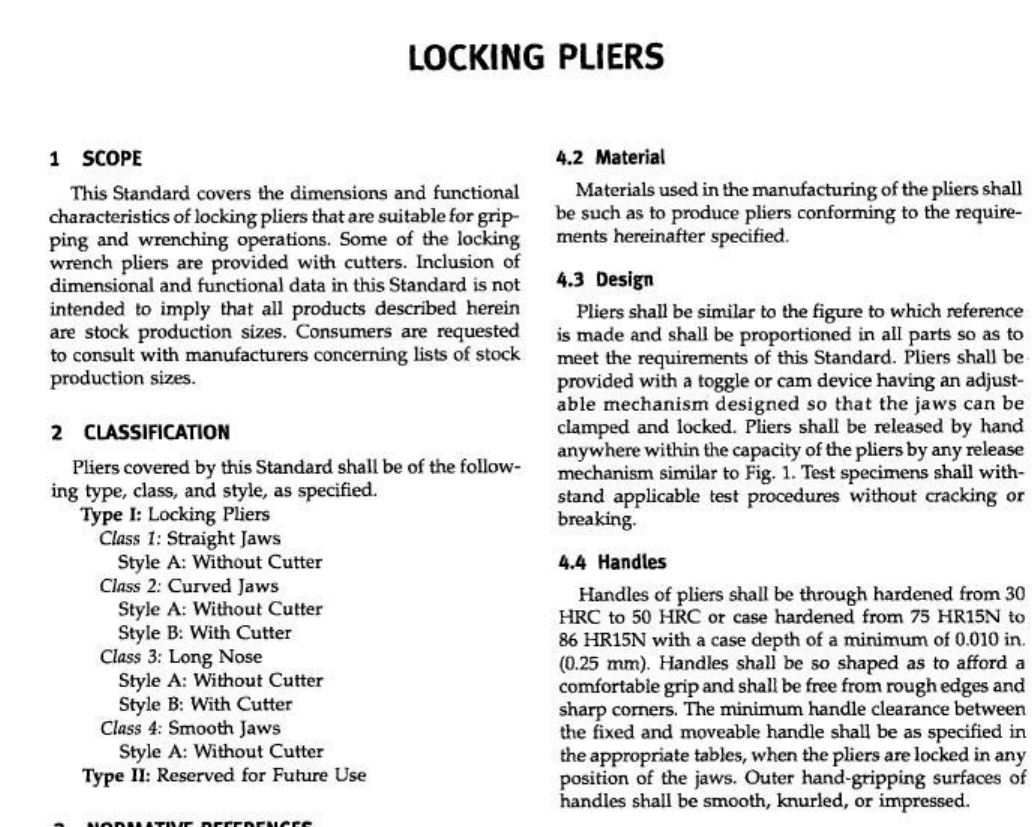ASME B107.24:2002 pdf free download LOCKING PLIERS
4.2 Material Materials used in the manufacturing of the pliers shall be such as to produce pliers conforming to the require- ments hereinafter specified.
4.3 Design Pliers shall be similar to the figure to which reference is made and shall be proportioned in all parts so as to meet the requirements of this Standard. Pliers shall be provided with a toggle or cam device having an adjustable mechanism designed so that the jaws can be clamped and locked. Pliers shall be released by hand anywhere within the capacity of the pliers by any release mechanism similar to Fig.1. Test specimens shall with- stand applicable test procedures without cracking or breaking.
4.4 Handles Handles of pliers shall be through hardened from 30 HRC to 50 HRC or case hardened from 75 HR15N to 86 HR15N with a case depth of a minimum of 0.010 in. (0.25 mm). Handles shall be so shaped as to afford a comfortable grip and shall be free from rough edges and sharp comers. The minimum handle clearance between the fixed and moveable handle shall be as specified in the appropriate tables, when the pliers are locked in any position of the jaws. Outer hand-gripping surfaces of handles shall be smooth, knurled, or impressed.
4.5 Joints Pliers joints shall have no excessive looseness, play, or any other indications of side play of the two halves of the pliers when opened or closed that would impair the function of pliers. Joint fasteners shall be through hardened from 25 HRC to 50 HRC. Where fasteners receive a case hardening treatment in addition to the through hardening, a maximum hardness of 60 HRC or equivalent will be permitted.
4.6 Jaws
4.6.1 Jaw Openings. Ends of jaws shall open, when adjusted by the screw, to the respective minimum dis- tance specified in Tables 4 through 8. Pliers shall operate in a smooth and uniform manner.
4.6.2 Jaw Hardness. Jaws shall be through hardened from 45 HRC to 60 HRC or case hardened from 83 HR15Nto 90 HR15N with a case depth minimum of0.010 in. (0.25 mm).
4.6.3 Jaw Serration. Serrated surfaces for Classes 1,2, and 3 shall have continuous and uniform sharp projec-tions.
4.7 Adjusting Screw
Adjusting screw located at the end of the handle shallhave a minimum hardness of 30 HRC.
4.8 Marking
Pliers shall be marked in a plain and permanent man-ner with the manufacturer’s name or with a trademarkof such known character that the source of manufactureand country of origin shall be readily determined. Mark-ing shall be as permanent as the normal life expectancyof the pliers, providing the surface to which it wasapplied has not been subjected to a fretting or abradingaction, and is capable of withstanding the cleaning nor-mally experienced during its intended use.
4.9 Finish
4.9.1 Appearance.Surfaces shall be tested in accor-dance with ASME B46.1.Surfaces shall be free from pits,nodules, burrs, and other conditions that may adverselyaffect the performance or appearance. Ground surfacesshall have a maximum surface roughness of 200 uin.(5.1 um) arithmetic average. Measurement of the finishshall be made with a measuring instrument using acutoff length of 0.03 in.(O.8 mm).
4.9.2 Coating. Coatings shall be adherent,smooth,continuous and free of pits, blisters, nodules, oxide scale,and any other conditions that may interfere with theprotective value and serviceability of the pliers.Cad-mium plate will not be allowed. Pliers shall be coatedwith a supplementary rust preventative treatment.
4.10 Spring
Spring shall be capable of opening the jaws to therespective minimum jaw opening tip-to-tip dimensionas specified in the tables for the individual type andclass of pliers.
4.11 Dimensions
Dimensions shall be determined by measuring thepliers with jaws in the closed and locked position. Theoverall length measurement shall include the adjustingscrew.
4.12 Workmanship
Requirements within this Standard are intended todescribe the best commercial quality pliers available.
5 TESTING PROCEDURES5.1 Safety
WARNING:MANY TESTS REQUIRED HEREIN ARE INHER-ENTLY HAZARDOUS AND ADEQUATE SAFEGUARDS FORPERSONNEL AND PROPERTY SHALL BE EMPLOYED INCONDUCTING SUCH TESTS.
5.2 Testing
5.2.1 Hardness lestHardnesses specified hereinshall be tested in accordance with ASME B107.25,para.5.3.
5.2.2 cut Test for Type I, Class 2,Styte B and Class3,Style B.The 4/4 in.(108 mm), 515 in.(140 mm), and5/4in. (133 mm) pliers shall cut 0.048 in z0.003 in. (1.22mm 土0.08 mm) diameter steel wire without readjustingthe pliers. Force required to lock the toggle mechanismand complete the cut shall not exceed 35 lbf (155 N).The 7 in.(178 mm) and 85 in. (216 mm) pliers shall cut0.091 in. i0.003 in.diameter (2.31 mm 50.08 mm) steelwire in not more than thnee progressive adjustments.Force required to lock the toggle mechanism in makingeach progressive cut shall not exceed 70 lbf (310 N).Steel wire used in these tests shall have a minimumtensile strength of 200,000 psi (1 378 MPa). Deformationor breakage of any part of the plicrs shall be cause forrejection.
ASME B107.24:2002 pdf free download
